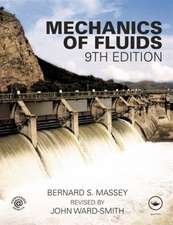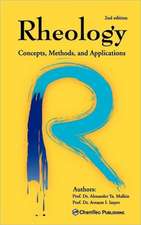Recent Results in Laminar-Turbulent Transition: Selected numerical and experimental contributions from the DFG priority programme "Transition" in Germany: Notes on Numerical Fluid Mechanics and Multidisciplinary Design, cartea 86
Editat de Siegfried Wagner, Markus Kloker, Ulrich Risten Limba Engleză Hardback – 11 sep 2003
| Toate formatele și edițiile | Preț | Express |
|---|---|---|
| Paperback (1) | 1218.83 lei 6-8 săpt. | |
| Springer Berlin, Heidelberg – 15 dec 2010 | 1218.83 lei 6-8 săpt. | |
| Hardback (1) | 1225.16 lei 6-8 săpt. | |
| Springer Berlin, Heidelberg – 11 sep 2003 | 1225.16 lei 6-8 săpt. |
Din seria Notes on Numerical Fluid Mechanics and Multidisciplinary Design
- 18%
 Preț: 1224.36 lei
Preț: 1224.36 lei - 18%
 Preț: 1818.79 lei
Preț: 1818.79 lei - 18%
 Preț: 1115.46 lei
Preț: 1115.46 lei -
 Preț: 413.66 lei
Preț: 413.66 lei -
 Preț: 413.07 lei
Preț: 413.07 lei -
 Preț: 413.84 lei
Preț: 413.84 lei - 18%
 Preț: 1232.26 lei
Preț: 1232.26 lei - 18%
 Preț: 1220.45 lei
Preț: 1220.45 lei - 24%
 Preț: 1044.04 lei
Preț: 1044.04 lei - 18%
 Preț: 1229.91 lei
Preț: 1229.91 lei - 18%
 Preț: 1224.36 lei
Preț: 1224.36 lei - 18%
 Preț: 1215.35 lei
Preț: 1215.35 lei - 18%
 Preț: 1222.80 lei
Preț: 1222.80 lei - 18%
 Preț: 1218.38 lei
Preț: 1218.38 lei - 18%
 Preț: 1223.55 lei
Preț: 1223.55 lei - 18%
 Preț: 1223.55 lei
Preț: 1223.55 lei -
 Preț: 411.93 lei
Preț: 411.93 lei - 18%
 Preț: 1832.22 lei
Preț: 1832.22 lei - 18%
 Preț: 1825.92 lei
Preț: 1825.92 lei - 18%
 Preț: 1225.94 lei
Preț: 1225.94 lei - 18%
 Preț: 1212.53 lei
Preț: 1212.53 lei - 18%
 Preț: 1222.45 lei
Preț: 1222.45 lei - 18%
 Preț: 1830.17 lei
Preț: 1830.17 lei - 18%
 Preț: 948.92 lei
Preț: 948.92 lei -
 Preț: 387.38 lei
Preț: 387.38 lei - 18%
 Preț: 1213.61 lei
Preț: 1213.61 lei - 18%
 Preț: 1243.29 lei
Preț: 1243.29 lei - 18%
 Preț: 952.09 lei
Preț: 952.09 lei
Preț: 1225.16 lei
Preț vechi: 1494.10 lei
-18% Nou
Puncte Express: 1838
Preț estimativ în valută:
234.44€ • 250.69$ • 195.47£
234.44€ • 250.69$ • 195.47£
Carte tipărită la comandă
Livrare economică 18 aprilie-02 mai
Preluare comenzi: 021 569.72.76
Specificații
ISBN-13: 9783540404903
ISBN-10: 3540404902
Pagini: 340
Ilustrații: XIII, 324 p.
Dimensiuni: 155 x 235 x 24 mm
Greutate: 0.66 kg
Ediția:2003
Editura: Springer Berlin, Heidelberg
Colecția Springer
Seria Notes on Numerical Fluid Mechanics and Multidisciplinary Design
Locul publicării:Berlin, Heidelberg, Germany
ISBN-10: 3540404902
Pagini: 340
Ilustrații: XIII, 324 p.
Dimensiuni: 155 x 235 x 24 mm
Greutate: 0.66 kg
Ediția:2003
Editura: Springer Berlin, Heidelberg
Colecția Springer
Seria Notes on Numerical Fluid Mechanics and Multidisciplinary Design
Locul publicării:Berlin, Heidelberg, Germany
Public țintă
Professional/practitionerCuprins
Invited Lectures.- On a universal mechanism of turbulence production in wall shear flows.- A general framework for stability, receptivity and optimal control.- The equivalent forcing model for receptivity analysis with application to the construction of a high-performance skin perforation pattern for LFC.- 1 Transition Mechanisms.- DNS investigations on the laminar breakdown in a three-dimensional boundary-layer flow.- Absolute/convective instability investigation of primary and secondary crossflow vortices.- Direct numerical simulation of the development of asymmetric perturbations at very late stages of the transition process.- Systematic investigations of 3D acoustic receptivity with respect to steady and unsteady disturbances. Experiment and DNS.- Three-dimensional steady disturbance modes in the Blasius boundary layer — a DNS study.- 2 Transition Prediction.- Industrial view on transition prediction.- Nonlinear nonlocal transition analysis — code development and results —.- Direct numerical simulation of instabilities in the compressible swept Hiemenz flow.- A combined numerical and experimental investigation of transition in a laminar separation bubble.- 3 Transition Control.- Generation and control of oblique Tollmien-Schlichting waves in a Blasius boundary layer.- DNS study of discrete suction in a 3-D boundary layer.- Active control of boundary-layer instabilities on an unswept wing.- Numerical investigations of active control of boundary-layer instabilities.- On the potential and the limitations of boundary-layer stabilization via active wave cancellation.- 4 Natural Transition and Measurement Techniques.- High resolution boundary layer profile sensors.- Propagation of Tollmien-Schlichting waves in a wing boundary layer.- Investigation of transitionalstructures in artificially excited boundary layer flows by means of stereo and multi-plane PIV.- Experimental investigations of natural and controlled transition on a laminar flow airfoil.- A hot-film measuring system for free flight conditions.- 5 Transition-Turbulence-Separation.- Comparison of two large-eddy simulations for a stalled airfoil flow using different finite-volume formulations.- Vernetzte Projektgruppen.- Visualization of unsteady flow structures in a high-performance computing environment.- Index of authors.
Textul de pe ultima copertă
This volume contains 24 papers presented at the international concluding colloquium of the German priority programme (DFG-Verbundschwerpunktprogramm) "Transition", held in April 2002 in Stuttgart. The unique and successful programme ran six years starting April 1996, and was sponsored mainly by the Deutsche Forschungsgemeinschaft, DFG, but also by the Deutsches Zentrum für Luft-und Raumfahrt, DLR, the Physikalisch-Technische Bundesanstalt Braunschweig, PTB, and Airbus Deutschland. The papers summarise the results of the programme and cover transition mechanisms, transition prediction, transition control, natural transition and measurement techniques, transition - turbulence – separation, and visualisation issues. Three invited papers are devoted to mechanisms of turbulence production, to a general framework of stability, receptivity and control, and a forcing model for receptivity analysis. Almost every transition topic arising in subsonic and transonic flow is covered.
Caracteristici
Recent results in laminar-turbulent transition Includes supplementary material: sn.pub/extras











